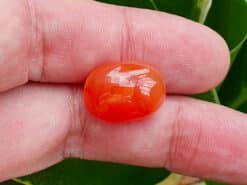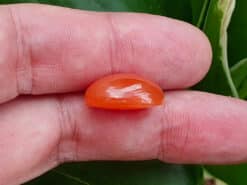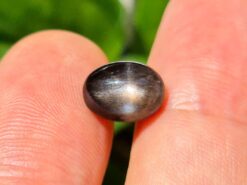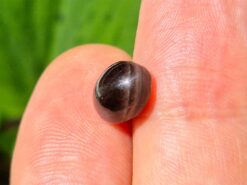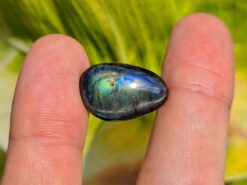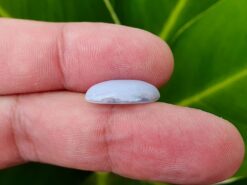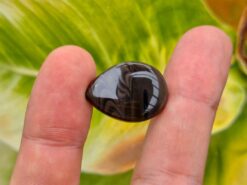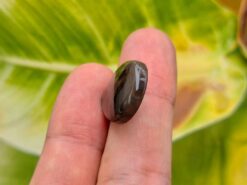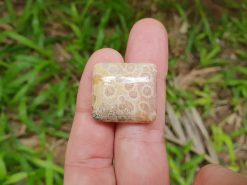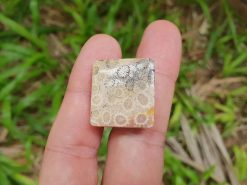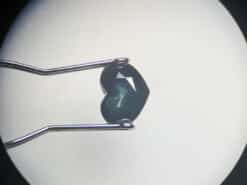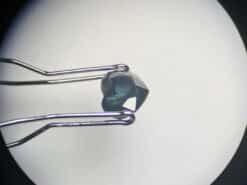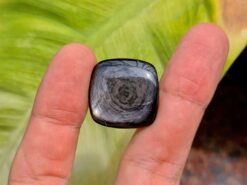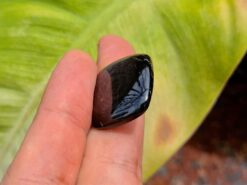Hibonite
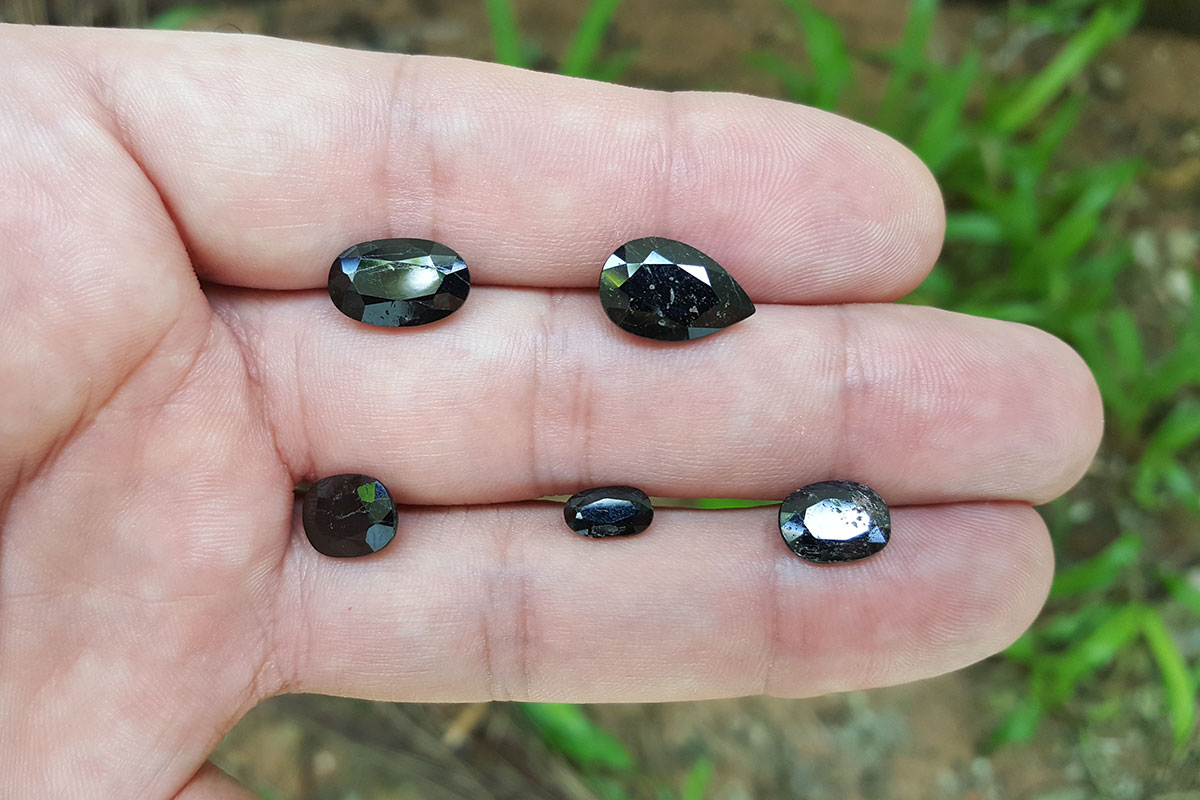
Hibonite gemstone ((Ca,Ce)(Al,Ti,Mg)12O19) is a distinctive brownish black mineral that captivates collectors and researchers due to its intriguing origin and rarity. Possessing a considerable hardness of 7.5-8.0 on the Mohs scale and crystallizing in a hexagonal system, the hibonite gemstone is particularly noteworthy for its formation under extreme conditions, both on Earth and within extraterrestrial materials. Highly sought after by mineral enthusiasts, this unusual gem displays subtle internal features and coloration that reflect its complex chemical composition and the dramatic geological environments in which it forms.
Buy natural gemstones in our gem shop
Hibonite gemstone
The hibonite gemstone is known for its exceptional scarcity in terrestrial contexts, most notably occurring within high-grade metamorphic rocks in Madagascar. This locality is well-known for producing some of the most visually appealing and scientifically significant specimens. In addition to its terrestrial occurrences, hibonite plays a substantial role in the study of the early solar system, as some presolar grains of hibonite have been identified in primitive meteorites. These tiny cosmic visitors often contain vital clues about the conditions that existed before our solar nebula fully formed, offering researchers important insights into the universe’s ancient past.
Hibonite is also a common mineral found in Ca-Al-rich inclusions (CAIs) present within certain chondritic meteorites. These inclusions are among the oldest solid materials to have formed in our solar system, making the hibonite gemstone an invaluable witness to early cosmic history. Beyond Earth, the stone is closely related to hibonite-Fe (IMA 2009-027, ((Fe,Mg)Al12O19)), an alteration mineral first identified in the Allende meteorite. This relationship helps demonstrate hibonite’s mineralogical variability and its capacity to incorporate different chemical elements under varying conditions.
Allende meteorite
The Allende meteorite, which fell over the Mexican state of Chihuahua on February 8, 1969, is the largest known carbonaceous chondrite to land on Earth. Over 2 tonnes of material were recovered after the observed fall, and its fragments have since served as a cornerstone of meteoritical research. Within some of these fragments, hibonite grains have been detected, further underscoring the importance of the hibonite gemstone in understanding the earliest moments of our solar system’s evolution. The presence of hibonite within such rare extraterrestrial objects continues to fuel ongoing scientific inquiry and excitement.
Discovery and Naming
The hibonite gemstone owes its name to Paul Hibon, a French prospector in Madagascar who discovered this mineral in June 1953. Recognizing its potential uniqueness, Hibon forwarded his samples to Jean Behier for further examination. Behier, suspecting the discovery of a new mineral species, provided the working name “hibonite.” Subsequent analysis by C. Guillemin at the Laboratoire de Minéralogie de la Sorbonne in Paris led to the mineral’s formal description in 1956 by Curien and collaborators.
Madagascar’s Esiva, Fort Dauphin region, Tuléar area, has produced some of the most distinguished hibonite specimens embedded within metamorphosed limestone matrixes rich in calcic plagioclase. Within this host rock, hibonite often occurs alongside minerals such as corundum, spinel, and thorianite. Its formation under these intense metamorphic conditions is a testament to the dynamic geological processes that shape Earth’s crust. Not to be confused with “Hibbenite,” the hibonite gemstone is a well-established species with its own distinct chemical and physical traits.
Formation and Occurrence
The formation of the hibonite gemstone is intimately tied to environments characterized by high temperatures and unique chemical conditions. On Earth, hibonite typically crystallizes in calcium-rich rock settings that have undergone intense metamorphism, allowing aluminum, titanium, and magnesium to bond with calcium and cerium. The result is a mineral boasting impressive stability and durability. Its notable hardness and resilience to weathering mean that natural hibonite specimens can persist for geologically significant periods, recording snapshots of the past conditions in which they formed.
Within meteorites, especially those containing CAIs, hibonite crystallized in the nascent solar nebula, under conditions unlike anything commonly seen on Earth today. These inclusions show that the hibonite gemstone was among the earliest minerals to condense out of the solar nebula’s hot gas and dust, making it a critical subject of study for cosmochemists and planetary scientists.
Scientific and Collectible Value
As a rare and scientifically important mineral, the hibonite gemstone commands attention from both mineral collectors and academic researchers. Its scarcity, combined with its link to meteorites and the early solar system, ensures that fine specimens are highly prized. While not traditionally used as a mainstream jewelry stone due to its rarity and the difficulty of finding facetable crystals, hibonite’s hardness makes it theoretically suitable for custom gemstone projects. Specialists and collectors who appreciate uncommon minerals often seek out hibonite for display pieces, relishing its dark, lustrous surfaces and subtle internal reflections.
To identify hibonite, mineralogists rely on its unique combination of physical properties, such as hardness, luster, and specific crystal forms, as well as its chemical signature. The stone’s strong pleochroism, uniaxial optical properties, and characteristic color variations provide multiple diagnostic criteria to confirm its authenticity. For researchers, hibonite’s presence in meteorites offers an unmatched window into cosmic processes, informing our understanding of planetary formation and the chemical evolution of the solar system.
Hibonite, from Madagascar
Hibonite properties
- Category: Oxide minerals
- Formula: (Ca,Ce)(Al,Ti,Mg)12O19
- Crystal system: Hexagonal
- Crystal class: Dihexagonal dipyramidal (6/mmm)
- H-M symbol: (6/m 2/m 2/m)
Identification
- Color: Brownish black to black; reddish brown in thin fragments; blue in meteorite occurrence
- Crystal habit: Prismatic platy to steep pyramidal crystals
- Cleavage: {0001} good, {1010} parting
- Fracture: Subconchoidal
- Mohs scale hardness: 7½ – 8
- Luster: Vitreous
- Streak: Reddish brown
- Diaphaneity: Semitransparent
- Specific gravity: 3.84
- Optical properties: Uniaxial (-)
- Refractive index: nω = 1.807(2), nε = 1.79(1)
- Pleochroism: O = brownish gray; E = gray
FAQ about Hibonite gemstone
What makes hibonite gemstone so rare?
The hibonite gemstone is considered rare due to its uncommon geological formation conditions and limited known deposits. Its scarcity is heightened by its presence in specialized metamorphic environments and in tiny grains within meteorites.
Can hibonite gemstone be used in jewelry?
While the hibonite gemstone is hard enough for jewelry and can theoretically be cut and polished, its rarity, scarcity of gem-quality crystals, and value as a collector’s specimen make it an unusual choice for conventional jewelry. Most pieces remain in collections or museums.
How do scientists study hibonite gemstone in meteorites?
Researchers use sophisticated analytical techniques, such as electron microprobe analysis and isotopic measurements, to investigate tiny grains of hibonite in meteorites. This research helps them understand the mineral’s formation conditions and the evolution of the early solar system.
How do I identify a hibonite gemstone?
Identification involves examining its physical characteristics—such as color, hardness, crystal habit, and luster—alongside its optical properties and chemical composition. Professional testing ensures accurate identification.
Is hibonite gemstone stable over time?
Hibonite is considered stable due to its strong bonding structure and resistance to weathering. Its durability allows it to persist within geological formations for extended periods, recording valuable information about Earth’s and the solar system’s distant past.

